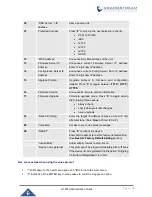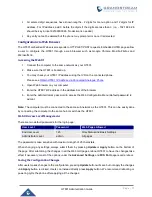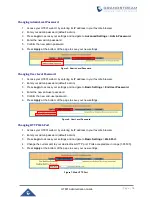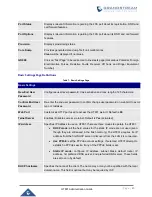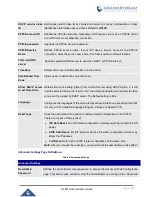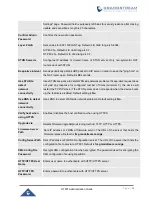
P a g e
|
30
HT801 Administration Guide
Validate Incoming
Messages
Validates incoming messages. Default is
No
.
Check SIP User ID
for Incoming
INVITE
Checks SIP User ID in the Request URI of incoming INVITE; if it doesn't match the
HT801 SIP User ID, the call will be rejected. Direct IP calling will also be disabled.
Default is
No
.
Authenticate
Incoming INVITE
Challenges the incoming INVITE for authentication with SIP 401 Unauthorized
message. Default is
No
.
Authenticate
server certificate
domain
Configures whether to validate the domain certificate when download the
firmware/config file. If it is set to "Yes", the phone will download the firmware/config file
only from the legitimate server. The default setting is "
No
".
Authenticate
server certificate
chain
Configures whether to validate the server certificate when download the firmware/config
file. If it is set to "Yes", the phone will download the firmware/config file only from the
legitimate server. The default setting is "
No
".
Trusted CA
Certificates
Uses the certificate for Authentication if “Check Domain Certificates” is set to “Yes”
under “Account” -> “SIP Settings”.
Allow Incoming SIP
Messages from SIP
Proxy Only
Checks SIP address of the Request URI in the incoming SIP message; if it doesn't
match the SIP server address of the account, the call will be rejected. Default is
No
.
Use Privacy
Header
Adds “Privacy” header if special feature is set to “Default”, and not “CBCOM”.
Use P-Preferred-
Identity Header
Adds “PPI” header if special feature is set to “Default”, and not “CBCOM”.
SIP REGISTER
Contact Header
Uses
Specifies which address (LAN or WAN address) the device will detect to use it in SIP
Register Contact Header. When set to
LAN
, Contact header will include local IP from
ATA in REGISTER messages, while if set to
WAN
, host/port/contact will be updated from
SIP 401/403/404/407 Via header "received"/"rport" parameters in REGISTER messages.
Default is
LAN Address
.
SIP T1 Timeout
Defines T1 timeout value. It is an estimate of the round-trip time between the client and
server transactions. For example, the HT801 will attempt to send a request to a SIP
server. The time it takes between sending out the request to the point of getting a
response is the SIP T1 timer. If no response is received the timeout is increased to
(2*T1) and then (4*T1). Request re-transmit retries would continue until a maximum
amount of time defined by T2. Default is
0.5
seconds.

